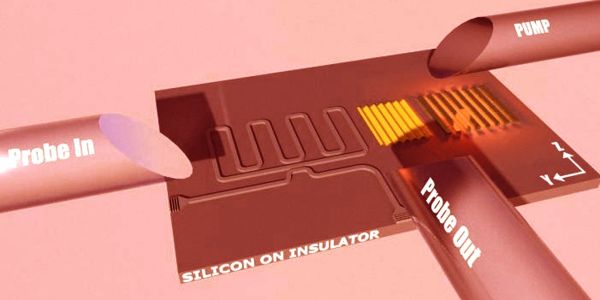Light is used to distribute signals in high-end wireless and cellular networks. The selective processing of such signals necessitates long delays, which are too long to support on a chip using only light. A research team combined light and ultrasonic waves to create ultra-narrow microwave signal filters in silicon integrated circuits. The concept allows for a great deal of flexibility in filter design.
The continued expansion of wireless and cellular data traffic is heavily reliant on light waves. Microwave photonics is a branch of technology concerned with the transmission and processing of electrical information signals via optical means. Microwave photonic systems can handle massive amounts of data when compared to traditional solutions based solely on electronics. As a result, microwave photonics has grown in importance as a component of 5G cellular networks and beyond. The creation of narrowband filters is a primary task of microwave photonics: the selection of specific data, at specific frequencies, from vast volumes carried over light.
Many microwave photonic systems are composed of discrete, separate components connected by long optical fiber paths. The cost, size, power consumption, and production volume requirements of advanced networks, on the other hand, necessitate a new generation of microwave photonic systems realized on a chip. Integrated microwave photonic filters, particularly those made of silicon, are in high demand. However, there is a fundamental problem: Narrowband filters require signals to be delayed for relatively long periods of time as part of their processing.
A research team brought together light and ultrasonic waves to realize ultra-narrow filters of microwave signals, in silicon integrated circuits. The concept allows large freedom for filter design.
“Because light travels at such a fast speed,” says Prof. Avi Zadok of Bar-Ilan University in Israel, “we run out of chip space before the necessary delays are accommodated.” The required delays could be more than 100 nanoseconds. Although such delays appear to be short in comparison to daily experience, the optical paths that support them are over ten meters long! Such long paths cannot be accommodated on a silicon chip. Even if we could fold over that many meters in a specific layout, the amount of optical power lost would be prohibitive.”
These long delays necessitate the use of a different type of wave, one that moves much more slowly. Zadok and his colleagues from the Faculty of Engineering and Institute of Nanotechnology and Advanced Materials at Bar-Ilan University, along with collaborators from the Hebrew University of Jerusalem and Tower Semiconductors, propose a solution in a study recently published in the journal Optica. They combined light and ultrasonic waves to create ultra-narrow microwave signal filters in silicon integrated circuits. The concept allows for a great deal of flexibility in filter design.

Moshe Katzman, a doctoral student at Bar-Ilan University, explains: “We’ve learned how to convert information from light waves to ultrasonic waves, surface acoustic waves, and back to optics. Surface acoustic waves travel at a rate 100,000 times slower. We can accommodate the delays that we require as part of our silicon chip within less than a millimeter and with very low losses.”
Acoustic waves have been used for information processing for over sixty years, but chip-level integration with light waves has proven difficult. Moshe Katzman goes on to say: “Over the last decade, we’ve seen ground-breaking demonstrations of how light and ultrasound waves can be combined on a chip device to form excellent microwave photonic filters. The platforms used, on the other hand, were more specialized. The solution’s simplicity contributes to its appeal. The fabrication of devices is based on silicon waveguide routine protocols. We’re not doing anything out of the ordinary here.” The realized filters are extremely narrowband: the spectral width of the passbands of the filters is only 5 MHz.
To realize narrowband filters, the information-carrying surface acoustic waves are imprinted multiple times on the output light wave. Maayan Priel, a doctoral student, elaborates: “Depending on the layout, the acoustic signal may cross the light path up to 12 times. Each of these occurrences imprints a copy of our signal of interest on the optical wave. These events are separated by long delays due to the slow acoustic speed. Their overall summation is what allows the filters to function.” The team reports complete control over each replica as part of their research, with the goal of realizing arbitrary filter responses.
Maayan Priel concludes: “The freedom to design the response of the filters is making the most out of the integrated, microwave-photonic platform.”















